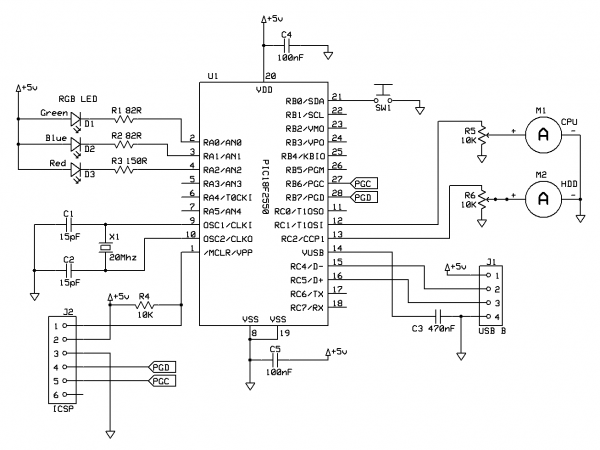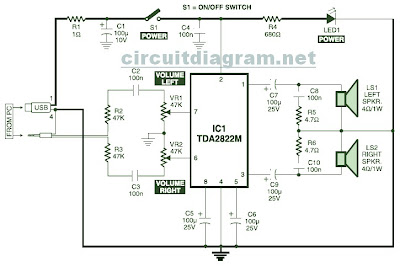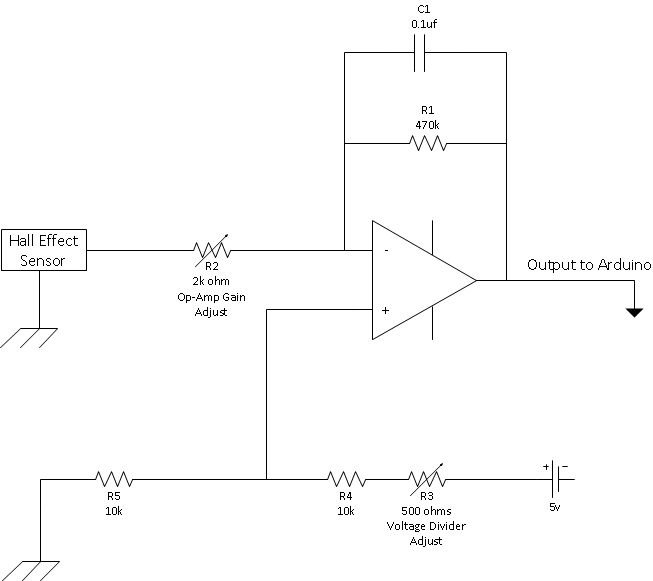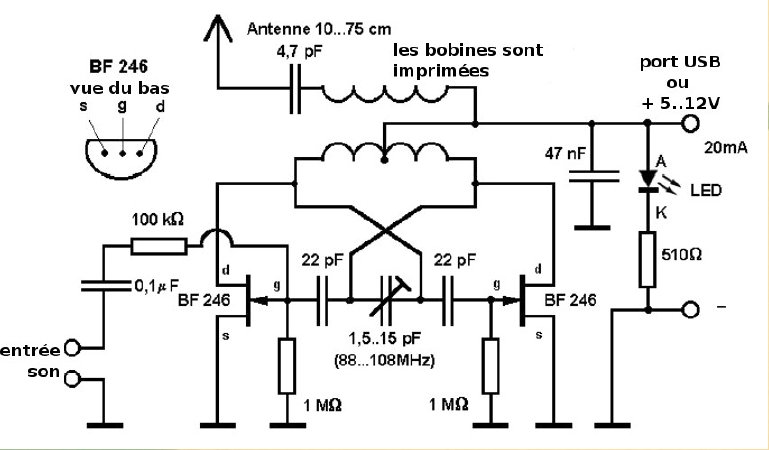
USB Performance Monitor

The USB Performance Monitor is a device based on the PIC18F2550 microcontroller, designed to display the performance of a computer using two analog meters and an RGB LED. The design incorporates a standard Hi-Fi VU meter controlled by pulse-width modulation (PWM) from the PIC18F microcontroller. This project originated from a request to relocate a computer's HDD LED to the desktop. After experimenting with sending Windows performance counters over USB via the Generic HID protocol, the concept of utilizing a VU meter was developed to create a comprehensive USB Performance Monitor. The HDD LED functionality is enhanced in this project, employing an RGB LED that adjusts its intensity based on utilization levels and changes color depending on read, write, or simultaneous operations. Additionally, a hardware button has been included to enable and disable the device quickly without needing to use a mouse. The firmware for the PIC18F2550 is programmed in Hi-Tech C, while the Windows host software is developed in C# using an open-source framework for USB Generic HID devices compatible with the PIC18F and Windows. The software is available under the GPL open-source license. The hardware design centers around the PIC18F2550 microcontroller, which features built-in USB capabilities. A minimal component count is utilized to connect the device to the USB port, switch, meters, and RGB LED. The overall circuit schematic is illustrated in the accompanying diagram. Two potentiometers are incorporated for easy calibration of the full-deflection power necessary for the VU meter, as this requirement can differ between meters. The design is straightforward; resistors for the RGB LED were selected based on the data sheet to maximize brightness since PWM will be used for output control. The PIC operates at a clock speed of 20 MHz to leverage the full 48 MHz PLL speed, which is beneficial for PWM control of the LED. To minimize the device's footprint, a single-sided PCB was designed. However, the circuit can also be constructed on strip-board if PCB etching equipment is unavailable. The PCB design features a downward-facing USB connector, facilitating internal case connections and allowing for cable routing out the back of the device. This configuration enables the use of different USB cables if needed. Alternatively, the cable can be soldered directly to the PCB or connected using another type of internal connection. All connected components utilize Molex-style connectors for ease of assembly and disassembly. A header for the PICkit 2 programmer is included to facilitate in-circuit firmware development. The RGB LED employed is a clear-lens type, which can make color mixing difficult to observe closely and results in high intensity. To diffuse the LED lens, it was buffed with a Dremel until it became milky white. If a Dremel is not available, fine sandpaper can achieve a similar effect. To modify the VU meter, the front plastic cover was removed, and a sharp knife was used to carefully cut behind the existing panel marker. Caution is advised to avoid damaging the meter's needles during this process. Once the panel marker was detached, it was scanned and imported into Photoshop to adjust the logarithmic VU markings to a linear percentage scale. After finalizing the design, it was printed for use.
The USB Performance Monitor effectively combines analog metering with digital control, providing a visually engaging way to monitor computer performance in real-time. The use of the PIC18F2550 microcontroller ensures efficient processing and communication capabilities over USB, while the PWM control of the RGB LED allows for dynamic visual feedback based on system activity. The incorporation of potentiometers for calibration enhances versatility, accommodating various VU meters and ensuring accurate readings. The design prioritizes compactness and user-friendliness, featuring a straightforward assembly process and accessible programming interfaces. Overall, this project exemplifies an innovative approach to integrating traditional analog components with modern digital technology, resulting in a practical tool for performance monitoring in computing environments.The USB Performance monitor is a PIC18F2550 based device which shows the performance of your computer using two analogue meters and a RGB LED. The design is based around a stock Hi-Fi VU-meter which is controlled using PWM from the PIC18F microcontroller.
This project was inspired by a friend of mine who wanted a way to move his computer`s HDD LED onto the desktop. After toying around with sending Windows performance counters over USB via the Generic HID protocol I came up with the idea of using a VU meter I had lying around to build a full USB Performance Monitor. Even the HDD LED itself is `improved` in this project. Instead of a single-colour flashing LED this project uses a RGB LED which varies its intensity based on the level of utilisation and its colour based on reading, writing or both.
Lastly a single hardware button was added to allow you to quickly enable and disable the device without having to grab the mouse. The PIC18F2550 firmware is written in Hi-Tech C and the Windows host software is written in C# using my Open Source Framework for USB Generic HID devices based on the PIC18F and Windows.
As always, the software is GPL open source and can be downloaded from the section at the end of this article. The hardware is based around the PIC18F2550 microcontroller which has on-board USB. A minimal component count was used to connect the device to the USB port as well as to the switch, meters and RGB LED.
The overall circuit schematic can be seen in the following diagram: Two potentiometers are included in the design to allow quick calibration of the full-deflection power required by the VU-meter (as this can vary from meter to meter). Other than that the design is fairly straight-forward; the RGB LED resistors were chosen according to the data-sheet to allow the highest brightness from the LED since we will be controlling the output using PWM.
The PIC is clocked at 20Mhz to allow the full 48Mhz PLL speed to be used, this is useful since PWM control of the LED requires as much processor speed as possible. In order to fit the device in the smallest possible space I designed a single-sided PCB. However, the design is simple enough to be easily built on a piece of strip-board if you don`t have PCB etching equipment.
Here is a picture of the PCB design: Note that the USB connector is facing downwards, this is to allow the connection to be plugged in inside of the case allowing the cable to be routed out the back of the device. This allows you to change the USB cable if required for a longer or shorter cable, however you could directly solder the cable to the PCB or use a different type of internal connection.
All of the connected devices connect using Molex style connectors to allow the device to be easily assembled and dissembled. I`ve also include a header for the PICkit 2 programmer to make it easier to develop the firmware by programming the PIC in-circuit.
The RGB LED I used was a clear-lens LED, this meant that the colour mixing was difficult to see close-up and also the LED was very intense. To cure this I diffused the LED lens by buffing it using a Dremel until the lens was milky-white. If you don`t have a Dremel you can do the same trick by simply rubbing the lens with fine sandpaper. To re-purpose the VU meter I took the front plastic off the meter and used a sharp knife to cut down behind the existing panel marker.
Be very careful when doing this; always cut down and away from yourself! You need to be careful not to push the panel marker up into the needles or you will bend them. Once the panel marker was removed I placed it in my scanner and scanned an image of it into Photoshop (this is a good trick since it preserves the scale of the original). I then used Photoshop to replace the logarithmic VU markings with a linear percentage scale (more about the logarithmic vs linear scales later!).
Once I had my desired design I simply printed it out onto th 🔗 External reference
The USB Performance Monitor effectively combines analog metering with digital control, providing a visually engaging way to monitor computer performance in real-time. The use of the PIC18F2550 microcontroller ensures efficient processing and communication capabilities over USB, while the PWM control of the RGB LED allows for dynamic visual feedback based on system activity. The incorporation of potentiometers for calibration enhances versatility, accommodating various VU meters and ensuring accurate readings. The design prioritizes compactness and user-friendliness, featuring a straightforward assembly process and accessible programming interfaces. Overall, this project exemplifies an innovative approach to integrating traditional analog components with modern digital technology, resulting in a practical tool for performance monitoring in computing environments.The USB Performance monitor is a PIC18F2550 based device which shows the performance of your computer using two analogue meters and a RGB LED. The design is based around a stock Hi-Fi VU-meter which is controlled using PWM from the PIC18F microcontroller.
This project was inspired by a friend of mine who wanted a way to move his computer`s HDD LED onto the desktop. After toying around with sending Windows performance counters over USB via the Generic HID protocol I came up with the idea of using a VU meter I had lying around to build a full USB Performance Monitor. Even the HDD LED itself is `improved` in this project. Instead of a single-colour flashing LED this project uses a RGB LED which varies its intensity based on the level of utilisation and its colour based on reading, writing or both.
Lastly a single hardware button was added to allow you to quickly enable and disable the device without having to grab the mouse. The PIC18F2550 firmware is written in Hi-Tech C and the Windows host software is written in C# using my Open Source Framework for USB Generic HID devices based on the PIC18F and Windows.
As always, the software is GPL open source and can be downloaded from the section at the end of this article. The hardware is based around the PIC18F2550 microcontroller which has on-board USB. A minimal component count was used to connect the device to the USB port as well as to the switch, meters and RGB LED.
The overall circuit schematic can be seen in the following diagram: Two potentiometers are included in the design to allow quick calibration of the full-deflection power required by the VU-meter (as this can vary from meter to meter). Other than that the design is fairly straight-forward; the RGB LED resistors were chosen according to the data-sheet to allow the highest brightness from the LED since we will be controlling the output using PWM.
The PIC is clocked at 20Mhz to allow the full 48Mhz PLL speed to be used, this is useful since PWM control of the LED requires as much processor speed as possible. In order to fit the device in the smallest possible space I designed a single-sided PCB. However, the design is simple enough to be easily built on a piece of strip-board if you don`t have PCB etching equipment.
Here is a picture of the PCB design: Note that the USB connector is facing downwards, this is to allow the connection to be plugged in inside of the case allowing the cable to be routed out the back of the device. This allows you to change the USB cable if required for a longer or shorter cable, however you could directly solder the cable to the PCB or use a different type of internal connection.
All of the connected devices connect using Molex style connectors to allow the device to be easily assembled and dissembled. I`ve also include a header for the PICkit 2 programmer to make it easier to develop the firmware by programming the PIC in-circuit.
The RGB LED I used was a clear-lens LED, this meant that the colour mixing was difficult to see close-up and also the LED was very intense. To cure this I diffused the LED lens by buffing it using a Dremel until the lens was milky-white. If you don`t have a Dremel you can do the same trick by simply rubbing the lens with fine sandpaper. To re-purpose the VU meter I took the front plastic off the meter and used a sharp knife to cut down behind the existing panel marker.
Be very careful when doing this; always cut down and away from yourself! You need to be careful not to push the panel marker up into the needles or you will bend them. Once the panel marker was removed I placed it in my scanner and scanned an image of it into Photoshop (this is a good trick since it preserves the scale of the original). I then used Photoshop to replace the logarithmic VU markings with a linear percentage scale (more about the logarithmic vs linear scales later!).
Once I had my desired design I simply printed it out onto th 🔗 External reference





